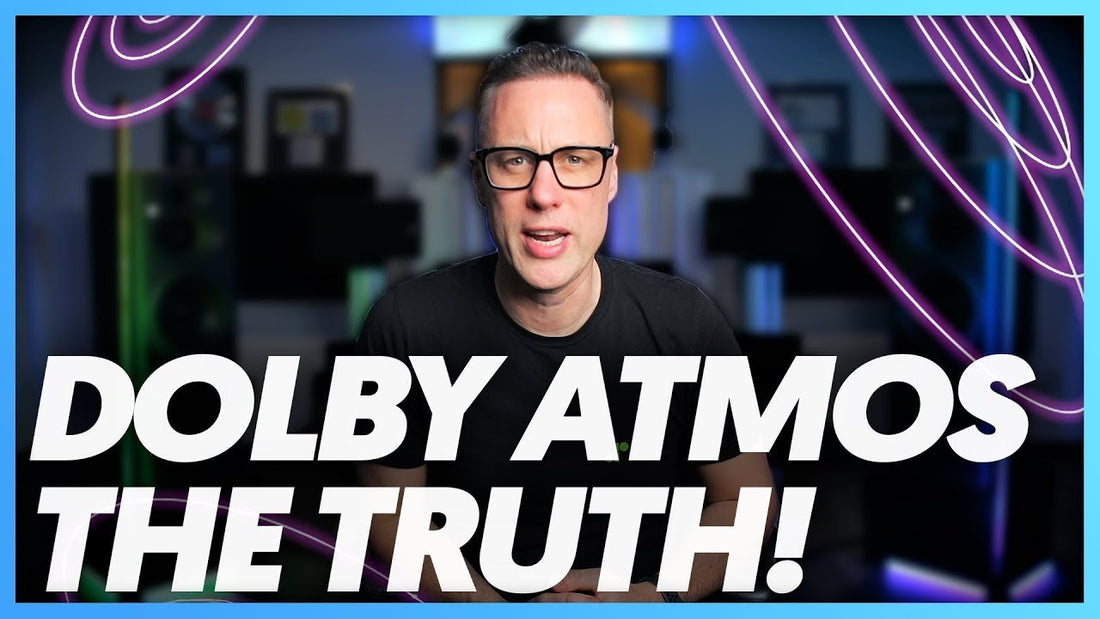
THE TRUTH about DOLBY ATMOS
Share
VIDEO TRANSCRIPTION
Welcome back. Today, I'm gonna spill the beans on Dolby Atmos and Sony 360 mixing and mastering. So you'll know by the end of this video, the inside knowledge on whether you should get involved or not? Or is this just a passing fad? Like these glasses?
Hi! If you are new here, my name is Streaky. I've been a high-end sound engineer for the past 25 years. Working with some of the world's leading artists. And I'm here to help you make music sound insane. Today, I think it's time I explain to those who haven't dived into the world of Atmos yet. Exactly what the state of player is. For a quick recap, Dolby Atmos Wise, it's been around for about 10 years, mainly in movies, but now recently it's got more on the music radar. Apple announced that they want all tracks mixed in what they're calling Spatial Audio.
As an incentive, they're offering all artists a better royalty percentage and also a higher listing on apple music. This led to all mixing and mastering engineers wetting their pants and spending 20 to 30K filling their room with tons of speakers. The current tracks that are getting the spatial treatment are mainly from major record label companies at the moment because of the price of producing another mix. So right at this present moment, unless you've got some really good contacts, I wouldn't start pawning your grand's jewelry to get yourself a big setup like this.
So once the dust is settled, this is how I see it going forward. If you are mixing or mastering engineer and you want to get involved. It might surprise you, but I think it's all gonna be exactly the same as it is now. Well, not exactly. Let me unpack this a touch more for you. To clear up the confusion, this is exactly how music production is working in 2022. First, the track is recorded and produced into a very basic mix. In the old days, this was called a monitor mix.
These days a limiter thrown over the top just to bring the level up. So when everyone's loving this monitor mix, the stems and that limited ref are sent off to the mix engineer. The mix engineer takes these stems, chops them, cleans them up, balances them. If you're watching my channel, you know exactly what a mix engineer does. They'll mix the stereo version and an Atmos version, stick a limiter on the end of the stereo one and send it off to the record label or their manager for approval. When everybody's loving these mixes and the tweaks have been done, its stereo pre-master and reference master are sent to the mastering engineer. But currently the Atmos mix isn't being sent and isn't being mastered.
If you've heard the difference between a premastered mix and a mastered mix, you'll agree with me that that's absolutely mental. As the Atmos mix will sound completely different to the stereo mastered file. This is understandable currently, as labels are having to convert existing mixes to Atmos mixes. But going forward, I see the process should be handled at the time of mastering. That way, getting a more consistent sound to the finished product. So when you’re mastering albums and there's been different mix engineers involved, you can get consistency across both the stereo and the Atmos mixes. As mastering engineer will be able to take tools like EQ, dynamics and limiting to be able to get tracks, to balance and sound consistent across the whole album.
I also believe a lot of Atmos mixes will be done on headphones because the way that Logic and Pro Tools have made this possible. So mastering will be the first chance for them to listen to their full Atmos mix, spread out across the speakers in a treated mastering environment.
So where does this leave you in the future? Should you get involved in Atmos? Many engineers will say it's the new quad or 5.1 and it's going nowhere. It's just a fad. I was involved with 5.1 mixing and mastering, and I believe we are now in a totally different world. Music now is just part of the entertainment world. It isn't the entertainment world as it was in the 80s, 90s. We can now listen on binaural headphones. We don't have to have special listening environments. We have soundbar that can project the sound around the room and virtual reality content that needs loads of spatial audio. So yes, I think it's here to stay. And so it's time for us to get some new skills - Atmos style. So make sure you subscribe and stay tuned, because I'll keep you updated on the Atmos journey.




